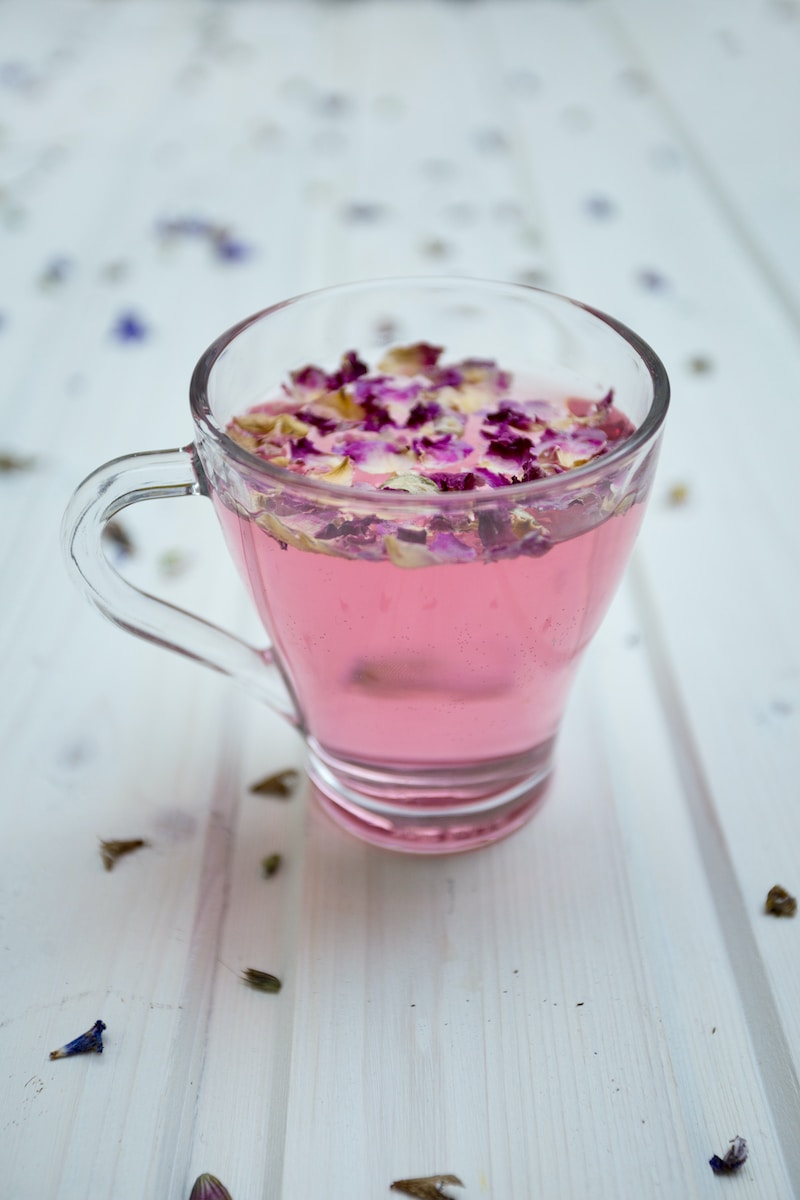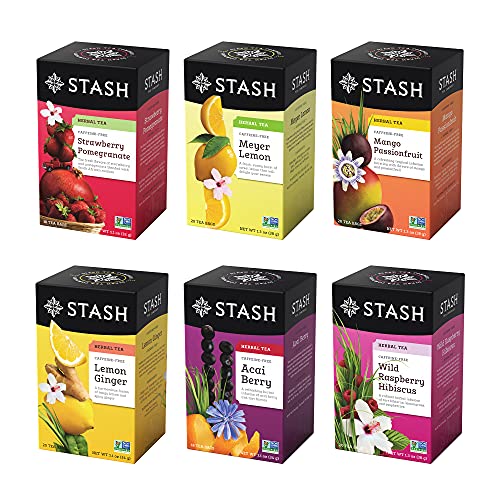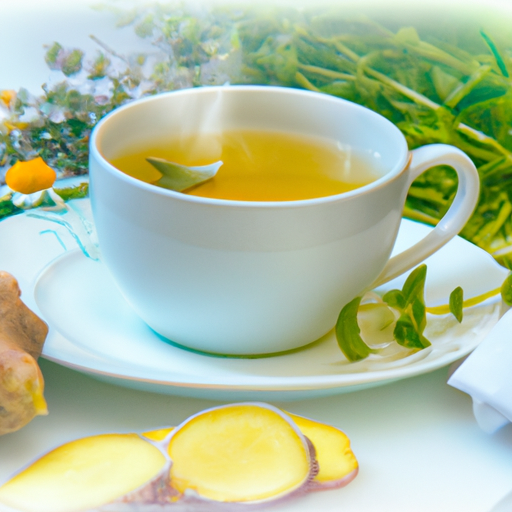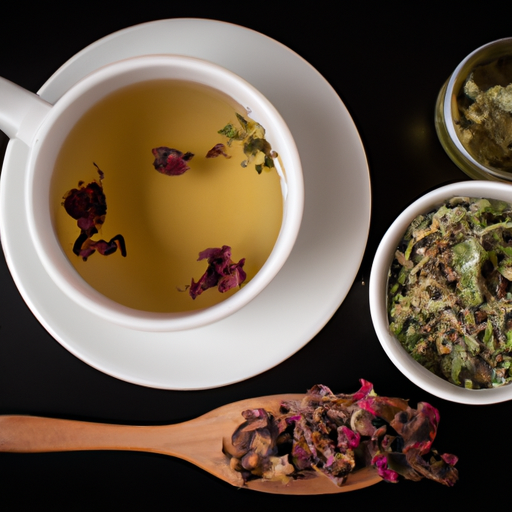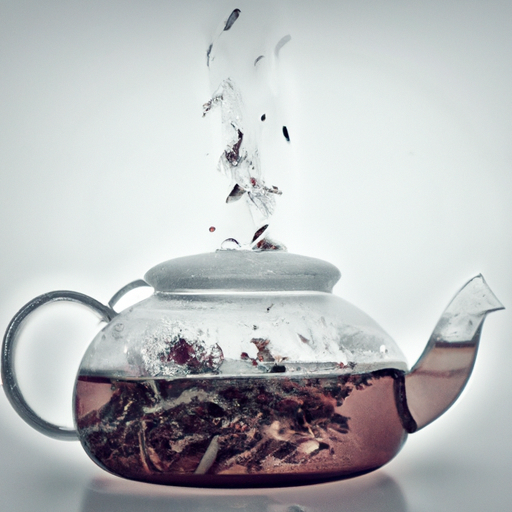Hi! Are you exhausted from handling hair that’s lackluster and devoid of vitality? I’ve got just the thing for you – a herbal tea rinse! That’s correct. This venerable beauty secret could be exactly what your hair needs to transform.
Using a herbal tea rinse on your hair is like giving it a rejuvenating spa treatment right at home. Not only does it add shine and vitality to your locks, but it also nourishes your scalp, promotes hair growth, and even helps with dandruff.
And the best part? It’s all-natural and super easy to make.
In this article, I’ll guide you through the step-by-step process of using a herbal tea rinse on your hair. From choosing the right blend of herbs to preparing and applying the rinse, I’ve got you covered.
So, get ready to transform your hair from drab to fab with this simple yet powerful herbal remedy. Trust me, your hair will thank you!
Key Takeaways
- Herbal tea rinses are a natural and effective way to rejuvenate dull and lifeless hair.
- Different herbs have different properties, such as peppermint for hair growth and chamomile for shine and highlights.
- Massaging the herbal tea rinse into the scalp and hair helps distribute it evenly and stimulate the scalp.
- Regular use of herbal tea rinses enhances the health and appearance of the hair, stimulating hair follicles and reducing dandruff and itchiness.
Choose the Right Herbal Tea Blend
When choosing the right herbal tea blend for your hair, it’s important to consider your specific hair needs and desired outcomes. Herbal tea rinses offer numerous health benefits and are a great addition to your natural hair care routine.
Different herbs have different properties that can help with various hair concerns such as dandruff, hair loss, and dryness. For example, peppermint tea can promote hair growth and soothe an itchy scalp, while chamomile tea can add shine and enhance natural highlights.
Researching the benefits of different herbs and experimenting with blends can help you find the perfect tea for your hair. Once you’ve chosen the right blend, it’s time to prepare the herbal tea rinse and experience the wonders it can do for your hair.
Prepare the Herbal Tea Rinse
To get your tresses ready for a soothing infusion, steep the fragrant blend in hot water like a warm hug for your locks. Herbal tea rinses have been used for centuries due to their numerous benefits for the hair. Not only do they provide a natural way to nourish and strengthen the hair, but they also help to soothe the scalp and promote hair growth. There are various herbal tea blends that you can choose from, each with its own unique set of benefits. For example, chamomile tea can lighten the hair, while rosemary tea can stimulate hair follicles. To prepare the herbal tea rinse, simply brew the tea blend of your choice and allow it to cool. Once cooled, strain the tea and pour it over your hair, gently massaging it into your scalp. Let it sit for a few minutes before rinsing it out. This simple yet effective step will leave your hair feeling refreshed and revitalized. Moving on to the next step of shampooing and conditioning your hair…
Shampoo and Condition Your Hair
Pamper yourself by lathering your locks with a luxurious shampoo and conditioning them for a silky smooth finish. When it comes to hair care, using natural remedies can work wonders.
After rinsing out the shampoo, apply a generous amount of conditioner, focusing on the ends of your hair. Gently massage it into your strands, allowing the formula to deeply nourish and hydrate. Leave the conditioner on for a few minutes to allow it to work its magic. Rinse thoroughly with warm water, ensuring no residue is left behind. This step is essential to maintain healthy and manageable hair.
Now that your hair is beautifully cleansed and conditioned, it’s time to move on to the next step: applying the herbal tea rinse.
Apply the Herbal Tea Rinse
To apply the herbal tea rinse, I start by massaging it into my scalp and hair, using my fingertips to work it in gently. This helps to distribute the rinse evenly and stimulate the scalp.
After massaging, I leave the rinse in for a few minutes to allow the herbal properties to penetrate and nourish my hair and scalp. This step is important for maximizing the benefits of the herbal tea rinse and promoting healthy hair growth.
Massage the rinse into your scalp and hair
Gently work the herbal tea rinse into your scalp and hair, giving your locks a refreshing and revitalizing treat. Massaging the rinse into your scalp not only feels amazing but also offers several benefits. Here are the best techniques for massaging your scalp:
- Circular motions: Use your fingertips to massage your scalp in small, circular motions. This helps improve blood circulation and promotes hair growth.
- Pressure points: Apply gentle pressure to specific points on your scalp, such as the temples or the base of your skull. This can help relieve tension and reduce stress.
- Kneading: Using your palms, knead your scalp in a gentle squeezing motion. This technique can help relax your scalp muscles and stimulate the hair follicles.
- Scalp scratching: Lightly scratch your scalp with your fingertips, moving from the front to the back. This not only feels great but also helps remove any buildup or flakes.
After massaging the rinse into your scalp and hair, leave it in for a few minutes before moving on to the next step.
Leave the rinse in for a few minutes
Allow the refreshing rinse to work its magic on your scalp and let the revitalizing sensation wash over you for a blissful few minutes.
Leaving the herbal tea rinse in your hair for longer durations can provide additional benefits. The longer the rinse sits on your hair, the more time the herbal properties have to penetrate the follicles and nourish your scalp. This can lead to improved hair strength, reduced breakage, and increased shine.
However, for those with specific hair types or concerns, there are alternatives to leaving the rinse in for just a few minutes. If you have oily hair, you may want to rinse it out sooner to prevent any residue buildup. If you have dry or damaged hair, consider leaving the rinse in for a longer period to allow the herbal ingredients to deeply moisturize and repair.
As we move on to the next step of rinsing your hair with cool water, you’ll notice the refreshing sensation intensify.
Rinse Your Hair with Cool Water
Start by running cool water through your hair, letting it flow over each strand and rinsing away any residue. Cool water has numerous benefits for your hair. It helps to seal the cuticle, resulting in smoother and shinier hair. Additionally, it can help to prevent frizz and lock in moisture.
Incorporating herbal tea rinses into your hair care routine is a great way to enhance the health and appearance of your hair. When rinsing with cool water, remember to massage your scalp gently to ensure that the rinse reaches all areas. After rinsing, gently squeeze out any excess water before proceeding with your regular styling routine.
By incorporating this step into your hair care routine regularly, you can enjoy the full benefits of herbal tea rinses and maintain healthy and beautiful hair.
Repeat the Process Regularly
To maintain healthy and beautiful hair, make sure to incorporate this step into your regular hair care routine. Using a herbal tea rinse regularly can provide numerous benefits for hair growth. The natural properties of the herbs in the rinse stimulate the hair follicles, promoting stronger and faster hair growth. Additionally, the tea rinse helps to balance the pH level of the scalp, reducing dandruff and itchiness.
However, it’s important to avoid common mistakes when using a herbal tea rinse. One mistake is using water that’s too hot, as it can strip the hair of its natural oils. Another mistake is leaving the rinse on for too long, which can lead to dryness.
By repeating this process regularly and avoiding these mistakes, you can enjoy the benefits of a herbal tea rinse, such as healthier and more vibrant hair.
Enjoy the Benefits of a Herbal Tea Rinse
Get ready to experience all the amazing perks of incorporating a herbal tea rinse into your hair care routine! Not only does it provide a natural and gentle way to nourish your hair, but it also offers several benefits for hair growth.
Here are some of the key benefits of using herbal tea for hair growth:
- Stimulates hair follicles: Herbal teas like rosemary and nettle are known to stimulate hair follicles, promoting hair growth and preventing hair loss.
- Strengthens and conditions: Chamomile and green tea are excellent choices for strengthening and conditioning the hair, leaving it soft, shiny, and manageable.
- Soothes the scalp: Peppermint and lavender herbal teas have soothing properties that can alleviate scalp irritation and dryness, promoting a healthier scalp environment for hair growth.
By incorporating different types of herbal teas into your hair care routine, you can enjoy a variety of benefits that contribute to the overall health and growth of your hair.
Frequently Asked Questions
How long should I leave the herbal tea rinse on my hair before rinsing it out?
I recommend leaving the herbal tea rinse on your hair for about 15-30 minutes. Leaving it on longer than that may cause dryness or build-up. It’s necessary to rinse it out to avoid these issues.
Can I use any type of herbal tea for the rinse, or are there specific ones that work best for certain hair types?
Different herbal teas work best for certain hair types. For example, chamomile is great for lightening blonde hair, while rosemary promotes hair growth. Herbal tea rinses are beneficial for hair growth and overall hair health.
Can I use the herbal tea rinse on colored or chemically-treated hair?
Yes, it is generally safe to use a herbal tea rinse on colored or chemically-treated hair. However, it’s important to note that using herbal tea rinse on damaged hair may have potential side effects.
How often should I repeat the herbal tea rinse process for optimal results?
For optimal results, how often should I repeat the herbal tea rinse on colored or chemically-treated hair? Using the rinse once a week is recommended. It helps maintain hair health while adding shine and promoting growth.
Can I apply the herbal tea rinse to dry hair, or does it need to be wet?
You can apply the herbal tea rinse to dry hair. Doing so allows the hair to fully absorb the benefits of the herbal tea, promoting shine, nourishment, and overall hair health.
Conclusion
In conclusion, using a herbal tea rinse on your hair can be a game-changer in your hair care routine. It not only provides a natural and gentle way to nourish and strengthen your hair, but it also offers a soothing and refreshing experience. Just like a cup of herbal tea can bring comfort to your soul, a herbal tea rinse can bring life to your hair, leaving it looking and feeling healthier than ever before.
So go ahead, indulge in the beauty secrets of nature and enjoy the transformative benefits of a herbal tea rinse.

